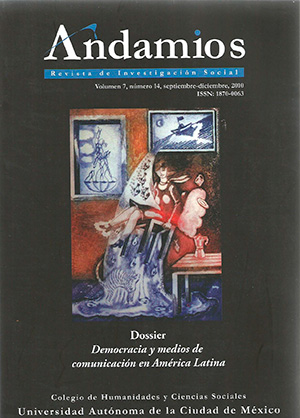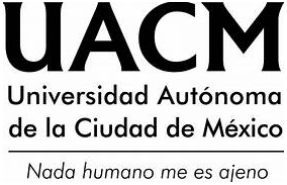VIDEO-SURVEILLANCE OF URBAN SPACE: TRAFFIC, SECURITY AND SOCIAL CONTROL
DOI:
https://doi.org/10.29092/uacm.v7i14.108Keywords:
Surveillance, guvernmentality, social control, social care, surveillance technologiesAbstract
In recent years, in Mexico and globally, closed circuit television (CCTV) has become the most pervasive surveillance model for urban spaces to record the daily activities of people. CCTV is not only a divices to support policies on security, organization of traffic, but instrument of social and political control. Taking the case of two municipalities in Mexico, this paper analyzes how these surveillance technologies allowing a certain management of the city as well as different forms of governmentality of population.
Downloads
References
AGAMBEN, G. (2007), Qu’est-ce qu’un dispositif?, París: Éditions Payot & Rivages.
ARTEAGA BOTELLO, N. (2007), “An orchestration of electronic survei- llance”, International Criminal Justice Review, vol. 17, núm. 4, Atlanta: Sage Publications, Georgia State University, College of Health and Human Sciences, pp. 325-335.
BECK, U. (1998), La sociedad del riesgo, Barcelona: Paidós. Bigo, D. (2006), “Security, exception, ban and surveillance”, en David Lyon (ed.), Theorizing Surveillance: The Panopticon and beyond, Cullompton, Portland: Willam Publishing, pp. 46-68.
BENNETT C., RAAB, C. y REAGAN, P. (2003), “People and Place: Patterns of Individual Identification within Intelligent Transportation Systems”, en David Lyon (ed.), Surveillance as Social Sorting: Privacy, Risk and Digital Discrimination, Londres: Routledge, pp. 153-175.
CAROL-MAYER, M., FAIRWEATHER, B. y CARSTEN STAHL, B. (2006), “CCTV Identity Management and Implications for Criminal Justice: Some Considerations”, Surveillance and Society, vol. 5, núm. 1, enero, Kingston: Surveillance Studies Network, Queen’s University, pp. 33-50.
COLEMAN, R. (2004), “Watching the Degenerate: Street Camera Sur- veillance and Urban Regeneration”, Local Economy, vol. 19, núm. 3, agosto, Londres: London South Bank University, pp. 199-211.
COLEMAN, R. y SIM, J. (2000), “‘You’ll Never Walk Alone’: CCTV Surveillance, Order and neo-liberal Rule in Liverpool City Centre”, British Journal of Sociology, vol. 51, núm. 4, diciembre, Londres: London School of Economics, pp. 623-639.
DELEUZE, G. y GUATTARI, F. (1989), Mil mesetas: capitalismo y esquizofrenia, Valencia: Pre-Textos.
DENICOLA, L. (2006), “The Bundling of Geospatial Information with Everyday Experience”, en T. Monahan (ed.), Surveillance and Security: Technological Politics and Power in Everyday Life, Londres: Routledge, pp. 243-264.
ERICSON, R. V. (2006), “Ten Uncertainties of Risk-Management Approaches to Security”, Canadian Journal of Criminology and Criminal Justice, vol. 48, núm. 3, junio, Ottawa: Canadian Cri- minal Justice Association, pp. 346-357.
FOUCAULT, M. (2004), Sécurité, territoire, population. Cours au Collège de France. 1977-1978, París: Seuil-Gallimard.
HAGGERTY, K. D. y ERICSON, R. V. (2000), “The Surveillant Assemblage”, British Journal of Sociology, vol. 51, núm. 4, diciembre, Londres: London School of Economics, pp. 605–622.
HERNÁNDEZ, C. (2008), “Instalarán cámaras de seguridad alrededor de Toluca”, El Sol de Toluca, 19 de abril, p. 56.
HIER, S. P., WALBY, K. y GREENBERG, J. (2006), “Supplementing the Panoptic Paradigm: Surveillance, Moral Governance and CCTV”, en David Lyon (ed.), Theorizing Surveillance: The Panopticon and beyond, Cullompton, Portland: Willam Publishing, pp. 230-244.
LYON, D. (1994), The Electronic Eye: the Rise of Surveillance Society, Mi- nnesota: University of Minnesota Press.
____________ (2001), Surveillance Society, Philadelphia: Open University Press.
____________ (2007), “Surveillance, Security and Social Sorting: Emerging Research Priorities”, International Criminal Justice Review, vol. 17, núm. 3, Atlanta: Georgia State University, College of Health and Human Sciences, pp. 161-170.
MARQUIS, G. (2003), “Private Security and Surveillance: from the ‘Dossier Society’ to Database Networks”, en David Lyon (ed.), Surveillance as Social Sorting: Privacy, Risk and Digital Discri- mination, Londres: Routledge, pp. 226-248.
MARX, G. T. (1988), Undercover: Police Surveillance in America, Los Angeles, CA: University of California Press.
NORRIS, C. (2003), “From Personal to Digital: CCTV, the Panopticon, and the Technological Mediation of Suspicion and Social Control”, en David Lyon (ed.), Surveillance as Social Sorting: Privacy, Risk and Digital Discrimination, Londres: Routledge, pp. 249-281.
NORRIS, C., MORAN, J. y ARMSTRONG, G. (eds.) (1998), Surveillance, Closed Circuit Television and Social Control, Aldershot: Ashgate.
PHILIPS, D. y CURRY, M. (2003), “Privacy and the Phenetic Urge: Geodemographics and the Changing Spatiality of Local Practice”, en David Lyon (ed.), Surveillance as Social Sorting: Privacy, Risk and Digital Discrimination, Londres: Routledge, pp. 137-152.
Published
Issue
Section
License
This Journal is licensed under Creative Commons Mexico 2.5. It is allowed to reproduce and disseminate the contents of the Journal for educational or research purposes, not for profit, as long as they are not mutilated and cite the source (Andamios, Revista de Investigación Social) and the author.
The copyright of the articles published in Andamios, Revista de Investigación Social are transferred by the author(s) to Universidad Autónoma de la Ciudad de México when the originals have been accepted, so that they are published and distributed both in the printed and electronic versions of the Journal. However, as established by law, the author(s) retains their moral rights. The author(s) will receive a form of assignment of copyright that they must to sign when their original has been accepted. In the case of collective articles, the signature of one of the authors will suffice, provided that the latter has obtained the consent of the others.
Authors may use the material of their article in other works or books published by themselves, with the condition of quoting Andamios as the original source of the texts.
The articles contained in this publication are the responsibility of their authors and do not compromise the official position of Andamios, Revista de Investigación Social of the Universidad Autónoma de la Ciudad de México.


